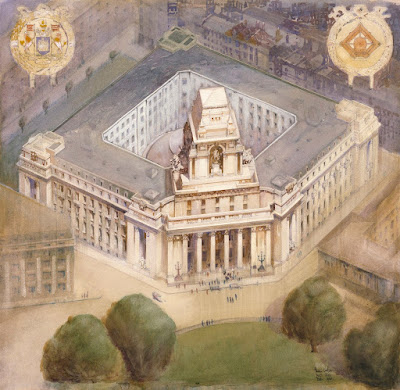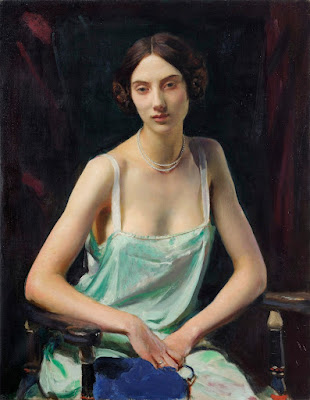 |
| Walter Russell Alice 1926 oil on canvas (diploma work) Royal Academy of Arts, London |
"Sir Walter Westley Russell became the Royal Academy's Keeper in 1927, continuing the work of his predecessor Charles Sims, who replaced the 'visitor' system of drop-in teaching by Royal Academicians with professional teaching staff directed by the Keeper. In doing so Russell helped bring teaching at the Royal Academy Schools into line with the educational model of the Slade School of Fine Art, where Russell was an assistant professor before becoming Keeper."
 |
| William Reid Dick The Child 1927 bianco del mare (i.e. limestone) statuette (diploma work) Royal Academy of Arts, London |
"William Reid Dick exhibited his Diploma Work at the Royal Academy in 1929, two years after exhibiting another statuette of the same title. The statuette had emerged as a particularly popular and accessible form of sculpture in the late nineteenth century."
 |
| Charles Ricketts Don Juan challenging the Commander ca. 1928 oil on canvas (diploma work) Royal Academy of Arts, London |
 |
| Henry Poole Young Pan 1928 marble (diploma work) Royal Academy of Arts, London |
"Young Pan is a late work, created in the year of Henry Poole's death. The figure of Pan was often identified in art and literature of the early twentieth century with a specifically English Arcadianism. Poole contrasted the smooth, defined features of the youthful Pan with the coarse marble from which they emerge – perhaps hinting at the innate 'earthiness' of Pan, often associated with fertility."
 |
| Sydney Lee The Red Tower 1928 oil on canvas (diploma work) Royal Academy of Arts, London |
 |
| Augustus John Portrait of a Young Man ca. 1928-29 oil on canvas (diploma work) Royal Academy of Arts, London |
"The 'young man' in this portrait is Augustus John's son Robin, in his early twenties at the time. Unlike John's earlier more highly finished portraits, which demonstrate his interest in the Old Masters, this informal and apparently spontaneous study reflects the artist's awareness of recent French art. According to his biographer Michael Holroyd, Augustus John painted energetically, 'with intense physical concentration,' often going up very close to his subject and staring hard before returning to the canvas."
 |
| Algernon Talmage Morning Glitter, Isle of Wight ca. 1929 oil on canvas (diploma work) Royal Academy of Arts, London |
 |
| Edwin Cooper Design for Port of London Authority 1930 drawing, with watercolor (diploma work) Royal Academy of Arts, London |
 |
| Gilbert Ledward Earth Rests 1930 Roman Stone (diploma work) Royal Academy of Arts, London |
 |
| Leonard Campbell Taylor Arabella ca. 1931 oil on canvas (diploma work) Royal Academy of Arts, London |
 |
| Wilfrid De Glehn Fishing ca. 1932 oil on canvas (diploma work) Royal Academy of Arts, London |
"De Glehn made several paintings such as this, in which young ladies are depicted enjoying themselves in idyllic outdoor settings. Stylistically and thematically, this summery scene shows the artist's affinity with the work of John Singer Sargent. De Glehn first came into contact with Sargent in the 1890s when assisting with Sargent's mural commission for Boston Public Library. The pair formed a lasting friendship, and De Glehn and his wife frequently accompanied Sargent on sketching tours abroad."
 |
| Meredith Frampton Still Life 1932 oil on canvas (diploma work) Royal Academy of Arts, London |
 |
| George Spencer Watson Portrait of a Woman ca. 1932 oil on canvas (diploma work) Royal Academy of Arts, London |
 |
| Laura Knight Dawn 1932-33 oil on canvas (diploma work) Royal Academy of Arts, London |
 |
| Terrick Williams St Michael's Mount, Cornwall 1933 oil on canvas (diploma work) Royal Academy of Arts, London |
 |
| W. Curtis Green London Life Association Building, King William Street ca. 1933 drawing (diploma work) Royal Academy of Arts, London |
 |
| William Russell Flint Castanets 1933 watercolor (diploma work) Royal Academy of Arts, London |
 |
| Frank Dobson Study for the Head of Pax 1933 bronze (diploma work) Royal Academy of Arts, London |
"This is the first study for the head of Dobson's Pax, a large sculpture of a reclining female figure in Portland stone. Its mottled surface was produced by layering a dull-brown patina over shiny bronze. Nowadays, Dobson is most often compared unfavourably to his contemporaries. A review in the Independent in 1994 reads, 'one has merely to compare his Pax, carved in 1934, which might have been impressive a decade earlier, with Barbara Hepworth's two versions of Mother and Child of the same year . . . to perceive an artist progressively out of step with the taste of his own time."
– quoted texts adapted from Royal Academy notes